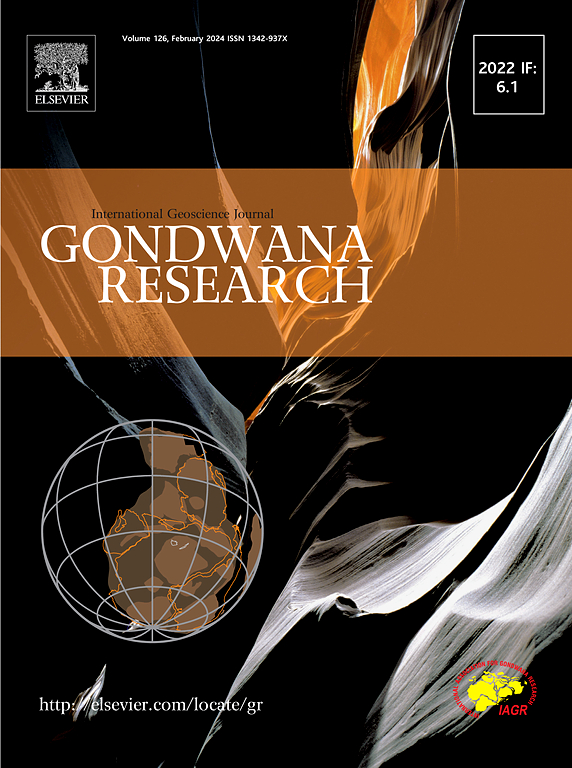Metamorphic evolution of overriding plate reveals the deep geodynamic process during continental subduction and collision: Insights from the North Qaidam tectonic belt, northern Tibetan Plateau
IF 7.2
1区 地球科学
Q1 GEOSCIENCES, MULTIDISCIPLINARY
引用次数: 0
Abstract
The timing and mechanism of the transition from continental subduction to exhumation (TSE) are important perspectives to decipher the tectonic evolution of orogenic belt. The difficulties in discriminating prograde, peak and retrograde eclogite-facies zircon in subducted continental rocks make it hard to constrain the timing of TSE. Actually, the TSE would cause the extension of the overriding plate and thus theoretically influence the metamorphic pressure–temperature evolution of rocks from the overriding plate, which, in turn, provides a potential approach to recover the TSE. An integrated study of petrography, mineral chemistry, zircon and monazite geochronology and geochemistry, conventional geothermometer and phase equilibrium modeling was carried out on the pelitic gneisses collected from Oulongbuluke block of the North Qaidam tectonic belt. The pelitic gneisses preserve distinct mineral assemblages, textures and compositions corresponding to prograde, peak, and retrograde metamorphism. Trace element signature and U–Pb geochronology of zircon and monazite record remarkable abundance changes of garnet and plagioclase at ca. 434 Ma. The data, coupled with P–T results obtained from conventional geothermometer and phase equilibrium modeling, reveal a clockwise pressure–temperature-time path, which is characterized by a peak P–T condition of 5.7–6.5 kbar and 713–736 °C at ca. 434 Ma, and a retrograde decompression and cooling process to 3.8–4.2 kbar and 659–672 °C; the metamorphic peak at ca. 434 Ma undoubtedly formed in the context of continental subduction and collision, and the retrograde decompression and cooling process of rocks from the overriding Oulongbuluke block fits well with the numerical results of deep slab-breakoff. The results link the first reported Silurian peak metamorphism of the Oulongbuluke block to the deep geodynamic process, and would help to understand the tectonic evolution of the North Qaidam tectonic belt and zircon behavior during metamorphism.

上覆板块的变质演化揭示了大陆俯冲碰撞的深部地球动力学过程——来自青藏高原北部柴达木北缘构造带的启示
从大陆俯冲到隆起(TSE)过渡的时间和机制是解读造山带构造演化的重要视角。由于难以区分俯冲大陆岩石中的顺行、峰值和逆行黝帘石,因此很难确定TSE的时间。实际上,TSE会导致凌覆板块的延伸,从而在理论上影响凌覆板块岩石的变质压力-温度演化,这反过来又为恢复TSE提供了一种潜在的方法。对从北柴达木构造带乌龙布卢克区块采集的辉长岩片麻岩进行了岩相学、矿物化学、锆石和独居石地质年代和地球化学、常规地温仪和相平衡模型的综合研究。辉长片麻岩保留了与顺变质、峰变质和逆变质相应的独特矿物组合、纹理和成分。锆石和独居石的微量元素特征和 U-Pb 地球年代学记录了石榴石和斜长石在约 434 Ma 时的显著丰度变化。434 Ma。这些数据与传统地质温度计和相平衡模型得出的 P-T 结果相结合,揭示了一条顺时针方向的压力-温度-时间路径,其特征是在约 434 Ma 时出现 5.7-6.5 kbar 和 713-736 °C的 P-T 峰值条件,并在约 434 Ma 时出现逆转。约 434 Ma 时达到 5.7-6.5 kbar 和 713-736 °C的变质峰值,然后逆行减压冷却至 3.8-4.2 kbar 和 659-672 °C。约 434 Ma 的变质峰值无疑是在大陆俯冲和碰撞的背景下形成的,而凌空的乌龙布吕克块体岩石的逆行减压和冷却过程与深板块断裂的数值结果非常吻合。这些结果将首次报道的乌龙布鲁克山块的志留纪高峰变质作用与深部地球动力学过程联系起来,有助于理解北柴达木构造带的构造演化和变质作用过程中的锆石行为。
本文章由计算机程序翻译,如有差异,请以英文原文为准。
求助全文
约1分钟内获得全文
求助全文
来源期刊

Gondwana Research
地学-地球科学综合
CiteScore
12.90
自引率
6.60%
发文量
298
审稿时长
65 days
期刊介绍:
Gondwana Research (GR) is an International Journal aimed to promote high quality research publications on all topics related to solid Earth, particularly with reference to the origin and evolution of continents, continental assemblies and their resources. GR is an "all earth science" journal with no restrictions on geological time, terrane or theme and covers a wide spectrum of topics in geosciences such as geology, geomorphology, palaeontology, structure, petrology, geochemistry, stable isotopes, geochronology, economic geology, exploration geology, engineering geology, geophysics, and environmental geology among other themes, and provides an appropriate forum to integrate studies from different disciplines and different terrains. In addition to regular articles and thematic issues, the journal invites high profile state-of-the-art reviews on thrust area topics for its column, ''GR FOCUS''. Focus articles include short biographies and photographs of the authors. Short articles (within ten printed pages) for rapid publication reporting important discoveries or innovative models of global interest will be considered under the category ''GR LETTERS''.
 求助内容:
求助内容: 应助结果提醒方式:
应助结果提醒方式:


